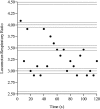Effect of cadence on locomotor-respiratory coupling during upper-body exercise
- PMID: 28032253
- PMCID: PMC5313582
- DOI: 10.1007/s00421-016-3517-5
Effect of cadence on locomotor-respiratory coupling during upper-body exercise
Abstract
Introduction: Asynchronous arm-cranking performed at high cadences elicits greater cardiorespiratory responses compared to low cadences. This has been attributed to increased postural demand and locomotor-respiratory coupling (LRC), and yet, this has not been empirically tested. This study aimed to assess the effects of cadence on cardiorespiratory responses and LRC during upper-body exercise.
Methods: Eight recreationally-active men performed arm-cranking exercise at moderate and severe intensities that were separated by 10 min of rest. At each intensity, participants exercised for 4 min at each of three cadences (50, 70, and 90 rev min-1) in a random order, with 4 min rest-periods applied in-between cadences. Exercise measures included LRC via whole- and half-integer ratios, cardiorespiratory function, perceptions of effort (RPE and dyspnoea), and diaphragm EMG using an oesophageal catheter.
Results: The prevalence of LRC during moderate exercise was highest at 70 vs. 50 rev min-1 (27 ± 10 vs. 13 ± 9%, p = 0.000) and during severe exercise at 90 vs. 50 rev min-1 (24 ± 7 vs. 18 ± 5%, p = 0.034), with a shorter inspiratory time and higher mean inspiratory flow (p < 0.05) at higher cadences. During moderate exercise, [Formula: see text] and f C were higher at 90 rev min-1 (p < 0.05) relative to 70 and 50 rev min-1 ([Formula: see text] 1.19 ± 0.25 vs. 1.05 ± 0.21 vs. 0.97 ± 0.24 L min-1; f C 116 ± 11 vs. 101 ± 13 vs. 101 ± 12 b min-1), with concomitantly elevated dyspnoea. There were no discernible cadence-mediated effects on diaphragm EMG.
Conclusion: Participants engage in LRC to a greater extent at moderate-high cadences which, in turn, increase respiratory airflow. Cadence rate should be carefully considered when designing aerobic training programmes involving the upper-limbs.
Keywords: Arm-cranking; Cardiorespiratory; Diaphragm; Entrainment; Respiratory muscle.
Conflict of interest statement
Conflict of interest
The authors declare that they have no conflict of interest.
Ethical approval
All procedures were performed in accordance with the ethical standards of the institutional research committee and with the 1964 Helsinki declaration and its later amendments or comparable ethical standards.
Figures



References
-
- Alty SR, Man WD, Moxham J, Lee KC (2008) Denoising of diaphragmatic electromyogram signals for respiratory control and diagnostic purposes. In: Proceedings of IEEE Engineering in Medicine and Biology Society, 30th Annual International Conference of the IEEE Engineering in Medicine and Biology Society, New York, USA, pp 5560–5563 - PubMed
-
- Beaver W, Wasserman K, Whipp B. A new method for detecting anaerobic threshold by gas exchange. J Appl Physiol. 1986;60(6):2020–2027. - PubMed
-
- Borg G. Borg’s Perceived exertion and pain scales. Champaign: Human Kinetics; 1998. pp. 50–51.
MeSH terms
LinkOut - more resources
Full Text Sources
Other Literature Sources
Medical
Miscellaneous

